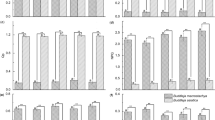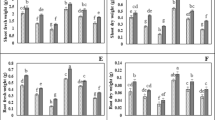Abstract
Characteristics of cadmium (Cd) accumulation and tolerance in Rorippa globosa (Turcz.) Thell., a species with some characteristics of cadmium hyperaccumulation were further investigated and compared with a closely related species, Rorippa islandica. The results showed that there was no phytotoxicity for R. globosa leaves or reduction in biomass when treated with 25 μg Cd g−1, although the concentration of Cd accumulated in the leaves was up to 218.9 μg Cd g−1 dry weight (DW). On the contrary, Cd toxicity was observed in R. islandica leaves by way of determining changes in fresh weight (FW), malondialdehyde (MDA) level and chlorophyll content while treated with 25 μg Cd g−1 DW. R. globosa had stronger self-protection ability than R. islandica to adapt to oxidative stress caused by Cd. Application of Cd significantly increased the activity of superoxide dismutase (SOD) in leaves, the activity of peroxidase (POD) in roots, and the activity of catalase (CAT) in leaves and roots of R. globosa. By contrast, in R. islandica, the activity of antioxidant enzymes was inhibited or unchanged by various Cd treatments. However, R. globosa leaves had higher activity of antioxidant enzymes such as SOD and POD than that of R. islandica. The antioxidative defense systems in R. globosa might play an important role in Cd tolerance. The Cd treatments significantly induced the synthesis of phytochelatins (PCs) in the two species. Leaf PCs and Cd accumulation by R. globosa were much greater than those by R. islandica, but root PCs and Cd accumulation by R. islandica were much greater than those by R. globosa, suggesting that PCs in leaves may be a biomarker of Cd hyperaccumulation, and the synthesis of PCs may be related to an increase in the uptake of Cd ions into the cytoplasm, not the primary mechanism for Cd tolerance.
Similar content being viewed by others
References
Assunçaõ AGL, Martins PD, De Folter S, Vooijs R, Schat H, Aarts MGM (2001) Elevated expression of metal transporter genes in three accessions of the metal hyperaccumulator Thlaspi caerulescens. Plant Cell Environ 24:217–226
Baker AJM, Brooks RR (1989) Terrestrial higher plants which hyperaccumulate metallic elements—a review of their distribution, ecology and phytochemistry. Biorecovery 1:81–126
Baker AJM, McGrath SP, Sidoli CMD, Reeves RD (1994) The possibility of in situ heavy metal decontamination of polluted soils using crops of metal-accumulating plants. Res Conserv Recycl 11:41–49
Blinda A, Abou-Mandour A, Azarkovich M, Brune A, Dietz KJ (1996) Heavy metal-induced changes in peroxidase activity in leaves, roots and cell suspension cultures of Hordeum vulgare L. In: Obinger C, Burner U, Ebermann R, Penel C, Greppin H (eds) Plant peroxidases, biochemistry and physiology. University of Agriculture, Wien, pp 374–379
Boominathan R, Doran PM (2003) Cadmium tolerance and antioxidative defenses in hairy roots of the cadmium hyperaccumulator, Thlaspi caerulescens. Biotechnol Bioeng 83:158–167
Brown SL, Chaney RL, Angle JS (1994) Phytoremediation potential of Thlaspi caerulescens and bladder campion for zinc-and cadmium-contaminated soil. J Environ Qual 23:1151–1157
Brown SL, Chaney RL, Angle JS, Baker AJM (1995) Zinc and cadmium uptake by hyperaccumulator Thlaspi caerulescens grown in nutrient solution. Soil Sci Soc Am J 59:125–133
Cai Y, Braids O (2002) Biogeochemistry of environmentally important elements. ACS Symposium Series 835. American Chemical Society, Oxford University Press, Washington, DC
Chance B, Maehly AC (1955) Assay of catalases and peroxidases. In: Colowick SP, Kaplan NO (eds) Methods in enzymology. Academic Press, New York, pp 764–775
Chaney RL, Malik M, Li YM, Brown SL, Brewer EP, Angle JS, Baker AJM (1997) Phytoremediation of soil metals. Curr Opin Biotechnol 8:279–284
Chaoui A, Mazhoudi S, Ghorbal MH, El Ferjani E (1997) Cadmium and zinc induction of lipid peroxidation and effects on antioxidant enzymes activities in bean (Phaseolus vulgaris L.). Plant Sci 127:139–147
Citterio S, Santagostino A, Fumagalli P, Prato N, Ranalli P, Sgorbati S (2003) Heavy metal tolerance and accumulation of Cd, Cr and Ni by Cannabis sativa L. Plant Soil 256:243–252
Cobbett CS (2000) Phytochelatin biosynthesis and function in heavy-metal detoxification. Curr Opin Plant Biol 3:211–216
Cosio C, Martinoia E, Keller C (2004) Hyperaccumulation of cadmium and zinc in Thlaspi caerulescens and Arabidopsis halleri at the leaf cellular level. Plant Physiol 134:716–725
Cosio C, DeSantis L, Frey B, Diallo S, Keller C (2005) Distribution of cadmium in leaves of Thlaspi caerulescens. J Exp Bot 56:765–775
De Knecht JA, van Baren N, Ten Bookum WM, Sang HWWF, Koevoets PLM, Schat H, Verkleij JAC (1995) Synthesis and degradation of phytochelatins in cadmium-sensitive and cadmium-tolerant Silene vulgaris. Plant Sci 106:9–18
Ebbs S, Lau I, Ahner B, Kochian L (2002) Phytochelatin synthesis is not responsible for Cd tolerance in the Zn/Cd hyperaccumulator Thlaspi caerulescens (J&C Presl.). Planta 214:635–640
Foyer CH, Descourvieres P, Kunert KJ (1994) Protection against oxygen radicals: an important defence mechanism studied in transgenic plants. Plant Cell Environ 17:507–523
Frey B, Keller C, Zierold K, Schulin R (2000) Distribution of Zn in functionally different leaf epidermal cells of the hyperaccumulator Thlaspi caerulescens. Plant Cell Environ 23:675–687
Garbisu C, Alkorta I (2001) Phytoextraction: a cost-effective plant-based technology for the removal of metals from the environment. Bioresource Technol 77:229–236
Gupta M, Tripathi RD, Rai UN, Chandra P (1998) Role of glutathione and phytochelatin in Hydrilla verticillata Royle and Vallisneria spiralis L. under mercury stress. Chemosphere 37:785–800
Havir EA, Brisson LF, Zelitch I (1996) Distribution of catalase isoforms in Nicotiana tabacum. Phytochemistry 41:699–702
Hegedüs A, Erdei S, Horváth G (2001) Comparative studies of H2O2 detoxifying enzymes in green and greening barley seedlings under cadmium stress. Plant Sci 160:1085–1093
Keltjens WG, Van Beusichem ML (1998) Phytochelatins as biomarkers for heavy metal toxicity in maize and wheat: combined effects of copper and cadmium. Plant Soil 21:635–648
Küpper H, Zhao FJ, McGrath SP (1999) Cellular compartmentation of zinc in leaves of the hyperaccumulator Thlaspi caerulescens. Plant Physiol 119:305–311
Küpper H, Lombi E, Zhao FJ, McGrath SP (2000) Cellular compartmentation of cadmium and zinc in relation to other elements in the hyperaccumulator Arabidopsis halleri. Planta 212:75–84
Küpper H, Mijovilovich A, Meyer-Klaucke W, Kroneck PM (2004) Tissue- and age-dependent differences in the complexation of cadmium and zinc in the cadmium/zinc hyperaccumulator Thlaspi caerulescens (Ganges Ecotype) revealed by X-ray absorption spectroscopy. Plant Physiol 134:748–757
Lasat MM, Pence NS, Garvin DF, Ebbs SD, Kochian LV (2000) Molecular physiology of zinc transport in the Zn hyperaccumulator Thlaspi caerulescens. J Exp Bot 51:71–79
Lee MY, Shin HW (2003) Cadmium-induced changes in antioxidant enzymes from the marine alga Nannochloropsis oculata. J Appl Phycol 15:13–19
Liu PC, Wang H, Cheng JQ, Huang JC (2004a) Regulation of nitric oxide on drought-induced membrane lipid peroxidation in wheat leaves. Acta Bot Boreal Occident Sin 24:141–145
Liu W, Shu WS, Lan CY (2004b) Viola baoshanensis, a plant that hyperaccumulates cadmium. Chin Bull Sci 49:29–32
Liu MQ, Yanai J, Jiang RF, Zhang FS, McGrath SP, Zhao FJ (2008) Does cadmium play a physiological role in the hyperaccumulator Thlaspi caerulescens? Chemosphere 71:1276–1283
Ma JF, Ueno D, Zhao FJ, McGrath SP (2005) Subcellular localisation of Cd and Zn in the leaves of a Cd-hyperaccumulating ecotype of Thlaspi caerulescens. Planta 220:731–736
Mocquot B, Vangronsvel DJ, Clijsters H, Mench M (1996) Copper toxicity in young maize (Zea mays L.) plants: effects on growth, mineral and chlorophyll contents, and enzyme activities. Plant Soil 82:287–300
Morishirta T, Boratynski K (1992) Accumulation of Cd and other metals in organs of plants growing around metal smelters in Japan. Soil Sci Plant Nutr 38:781–785
Navari-Izzo F, Quartacci MF (2001) Phytoremediation of metals: mechanisms against oxidative stress. Minerva Biotechnol 13:73–83
Reeves RD (2003) Tropical hyperaccumulators of metals and their potential for phytoextraction. Plant Soil 249:57–65
Reeves RD, Baker AJM (2000) Metal-accumulating plants. In: Raskin I, Ensley BD (eds) Phytoremediation of toxic metals: using plants to clean up the environment. Wiley, New York, pp 193–229
Salt DE, Smith RD, Raskin I (1998) Phytoremediation. Annu Rev Plant Physiol Plant Mol Biol 49:643–668
Sandalio LM, Dalurzo HC, Gomez M, Romero-Puertas MC, del Rio LA (2001) Cadmium-induced changes in the growth and oxidative metabolism of pea plants. J Exp Bot 52:2115–2212
Sanità di Toppi L, Gabbrielli R (1999) Response to cadmium in higher plants. Environ Exp Bot 41:105–130
Schat H, Llugany M, Vooijs R, Hartley-Whitaker J, Bleeker PM (2002) The role of phytochelatins in constitutive and adaptive heavy metal tolerances in hyperaccumulator and non-hyperaccumulator metallophytes. J Exp Bot 53:2381–2392
Shaw BP (1995) Effect of mercury and cadmium on the activities of antioxidative enzymes in the seedlings of Phaseolus aureus. Biol Plant 37:587–596
Somashekaraiah BV, Padmaja K, Prasad ARK (1992) Phytotoxicity of cadmium ions on germinating seedlings of mung bean (Phaseolus vulgaris): involvement of lipid peroxides in chlorophyll degradation. Physiol Plant 85:85–89
Srivastava M, Ma LQ, Singh N, Singh S (2005) Antioxidant responses of hyper-accumulator and sensitive fern species to arsenic. J Exp Bot 56:1335–1342
Sun RL, Zhou QX, Sun FH, Jin CX (2007) Antioxidative defense and proline/phytochelatin accumulation in a newly-discovered Cd-hyperaccumulator, Solanum nigrum L. Environ Exp Bot 60:468–476
Uraguchi S, Watanabe I, Yoshitomi A, Kiyono M, Katsuji K (2006) Characteristics of cadmium accumulation and tolerance in novel Cd-accumulating crops, Avena strigosa and Crotalaria juncea. J Exp Bot 57:2955–2965
Van Assche F, Clijsters H (1990) Effect of metal on enzyme activity in plants. Plant Cell Environ 13:195–206
Vitoria AP, Lea PJ, Azevedo RA (2001) Antioxidant enzymes responses to cadmium in radish tissues. Phytochemistry 57:701–710
Wei SH, Zhou QX (2006) Phytoremdiation of cadmium-contaminated soils by Rorippa globosa using two-phase planting. Environ Sci Pollut Res 13:151–155
Wei CY, Chen TB, Huang ZC (2002) Cretan bake (Pteris cretica L.): an Arsenicaccumulating. Plant Acta Ecol Sin 22:777–782
Wei SH, Zhou QX, Wang X, Zhang KS, Guo GL (2004) A newly-found Cd-hyperaccumulator Solanum nigrum L. Chin Bull Sci 49:2568–2573
Wójcik M, Vangronsveld J, Tukiendorf A (2005) Cadmium tolerance in Thlaspi caerulescens I. Growth parameters, metal accumulation and phytochelatin synthesis in response to cadmium. Environ Exp Bot 53:151–161
Wójcik M, Skórzyńska-Polit E, Ukiendorf A (2006) Organic acids accumulation and antioxidant enzyme activities in Thlaspi caerulescens under Zn and Cd stress. Plant Growth Regul 48:145–155
Wu YX, von Tiedemann A (2002) Impact of fungicides on active oxygen species and antioxidant enzymes in spring barley (Hordeum vulgare L.) exposed to ozone. Environ Pollut 116:37–47
Yang X, Long XX, Ye HB, He ZL, Stoffella PJ, Calvert DV (2004) Cadmium tolerance and hyperaccumulation in a new Zn-hyperaccumulating plant species (Sedum alfredii Hance). Plant Soil 259:181–189
Yen TY, Villa JA, DeWitt JG (1999) Analysis of phytochelatin-cadmium complexes from plant tissue culture using nano-electrospray ionization tandem mass spectrometry and capillary liquid chromatography/electrospray ionization tandem mass spectrometry. J Mass Spectrom 34:930–941
Yurekli F, Porgali ZB (2006) The effects of excessive exposure to copper in bean plants. Acta Biol Cracov Bot 48:7–13
Zenk MH (1996) Heavy metal detoxification in higher plants—a review. Gene 179:21–30
Zhou QX, Song YF (2004) Principles and methods of contaminated soil remediation. Science Press, Beijing
Acknowledgments
The research was financially supported by the Ministry of Science and Technology, People’s Republic of China as an 863 project (No. 2007AA061201), and by the Ministry of Education, People’s Republic of China as a grand fostering project (No. 707011), respectively.
Author information
Authors and Affiliations
Corresponding author
Rights and permissions
About this article
Cite this article
Sun, R., Jin, C. & Zhou, Q. Characteristics of cadmium accumulation and tolerance in Rorippa globosa (Turcz.) Thell., a species with some characteristics of cadmium hyperaccumulation. Plant Growth Regul 61, 67–74 (2010). https://doi.org/10.1007/s10725-010-9451-3
Received:
Accepted:
Published:
Issue Date:
DOI: https://doi.org/10.1007/s10725-010-9451-3




